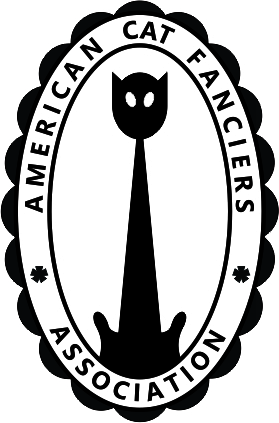 American Cat Fanciers Association
American Cat Fanciers Association
Norwegian Forest Cat Breeders' Directory
~~~~~~~~~~~~~~~~~~~~~~~~~~~~~~~~~~~~~~~~~~~~~~~~~~~~~~~~~~~
Until 1938, the Forest Cat was just a domestic cat like any other cat in Norway. This lynx-like cat was called the "Skaukatt" by people who knew about its existence. No one really cared about this longhaired stray cat except the farmer, who appreciated this big, beautiful -domestic cat. Forest Cats can still be found on farms in Norway.
No one really knows how long Forest Cats have existed In Norway. They may be descendants of shorthaired cats brought In from England by the Vikings and longhaired cats brought in by the Crusaders. They, do not look like Persians or like longhaired shorthair cats. They are something very special. The rough Norwegian climate has been hard on humans, but It has been a blessing to the cats. The Norwegian Forest Cat has become what It Is today because only the fittest remained alive. As these cats had to feed and defend themselves from enemies in the forests, only the ones who were best at hunting and fast to escape from predators survived. Cats who lived through their first winter were long legged. springy, intelligent and brave. This very special breed evolved without any human interference.
In 1975 an association called "Norsk Skogkattring' was
established in order to lead the breeding in the right direction. Strict
rules were followed by the breeders. Only genuine Forest Cats were
allowed In the breeding program. In order to control this, meetings were
arranged and cat owners were Invited to come and show their cat before
the Breed Committee. Only cats recognized by the Committee could be
registered as such.
In describing the Forest Cat, the foremost characteristic is
disposition. Their purr boxes are constantly working and they
continually-exhibit their love of people. If they have a fault, it is,
that they want to be with you and love you all the time. With a Forest
Cat In the house you have to close the door to get any privacy. True to
their origins in the forests, they are exceedingly alert and very
intelligent. A Norwegian Forest Cat Is a big and strongly built cat with
a medium length body and hind logs higher than the front legs. It is
muscular and heavy boned. The head is triangular shaped with all three
sides equal. The profile is long and straight with no break, stop, or
bump, and the cat has a strong chin. The eyes are extremely expressive,
large and almond shaped set at a slight angle with the outer comer
slightly higher than the Inner comer. All eye colors are accepted.
including blue and odd-eyed whites. The ears are medium large, set on
the head so that they follow the line of the triangle from the outer
base of the ears down to the chin. The ears are well tufted and many of
the cats have lynx-like tips. The tail is long and flowing and carried
high. The Norwegian Forest Cat comes in every color but color pointed.
The breed Is known for its long. rich fur with a woolly undercoat
covered by long guardhairs. This coat is warm and water-repellent
requiring less grooming than some other longhair cats. The ruff in
winter Is truly magnificent, exhibiting three separate sections: a short
back of the neck ruff, side mutton chops, and a full frontal bib. When
feeling the coat, one should get the feeling of denseness especially on
the tabbies. Solids, bi-colors, and tri-colors often have a softer coal
The length of the coat is semi-long which means that it should not be as
long as a Persian coat.
The development of the
coat is very special. As a kitten the Norwegian Forest Cat has a long
woolly coat. At the age of three months the kitten coat starts to
change, and for a long time (sometimes several months) the kitten looks
shorthaired except for a bushy tail., The guardhairs start to grow when
the kitten is about five months old, but can take-a long time to
develop. Some of the cats do not have a fully mature coat until they are
two years old. The Forest Cat appears almost shorthaired in the summer.
The undercoat drops in the spring, and the new undercoat starts growing
in the fall. Indoor cats and outdoor cats have different coats. The
outdoor cat develops a much more woolly undercoat than a cat that is
kept inside, however the Norwegian Forest Cat is well suited to indoor
life.
The overall appearance is of an alert, healthy, firm, muscular. and
well proportioned cat. The males are large and imposing (averaging 12 to
15 lbs) while the females are considerably smaller. It should be noted
that this breed is not fully mature until five years of age. The
Norwegian females are especially good mothers, keeping their offspring
in tow as long as you will let them, and have been known to readily
adopt other kittens as well.
November 1, 1979 saw the entry of the first breeding pair Into the United States. Currently there are over 500 registered Norwegian Forest Cats in the U.S. The Forest Cat has been accepted for registration in six associations: ACA, ACFA, CFA, CFF, CROWN, and MCA. They are accepted for championship competition in ACFA. CFF, CROWN, and TICA.
.jpg)
Lynn
Landers - Dickinson
Cattery:
Catequil
(515)
314-3376
Bondurant, IA